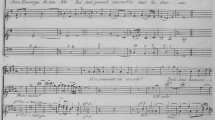Abstract
This article reevaluates Wackenroder’s complex intervention in the musical Empfindsamkeit, given his insight into the mathematical, hence “mechanical” aspects of music as a language of feeling, and the relation of that insight to his peculiar re-appropriation of Christian motifs. Wackenroder’s musical phantasmagoria demonstrates music’s capacity, as a mechanical art, to reveal feelings in their “fallen” condition.
Zusammenfassung
Es wird Wackenroders Intervention in die musikalische Empfindsamkeit neu eingeschätzt. Dabei wird von der Einsicht Wackenroders in die mathematische, bzw. „mechanische“ Seite der Musik als Sprache des Gefühls, sowie des Verhältnisses dieser Einsicht zu seiner merkwürdigen Wiederaneignung christlicher Motive ausgegangen. Die musikalische Phantasmagorie zeigt die Fähigkeit von Musik als mechanischer Kunst, Gefühle in ihrer „Verfallenheit“ zu offenbaren.
Similar content being viewed by others
Author information
Authors and Affiliations
Rights and permissions
About this article
Cite this article
Benert, C. Joseph Berglinger’s Musical Crucifixion: Harmony, Alterity, and the Theater of the Passions in the Writings of Wilhelm H. Wackenroder. Dtsch Vierteljahrsschr Literaturwiss Geistesgesch 78, 20–54 (2004). https://doi.org/10.1007/BF03379205
Published:
Issue Date:
DOI: https://doi.org/10.1007/BF03379205




